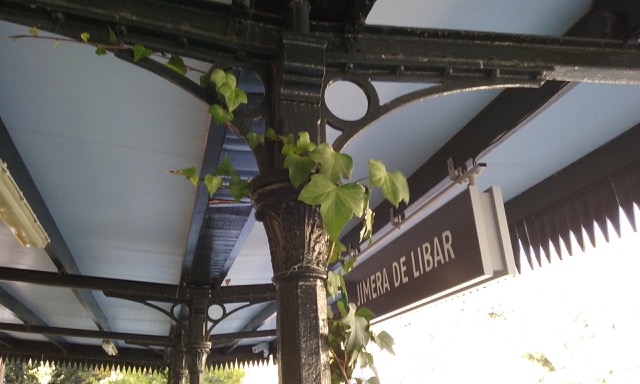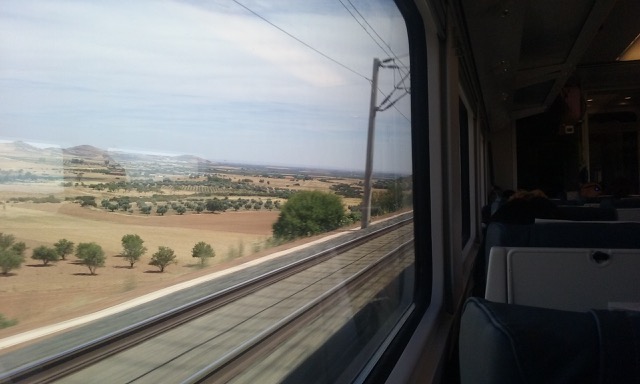
Last week, I was a substitute for an English teacher in town. Summer being here and exams over, I asked the giggly teenagers about their preferred mode of travel. They all answered Planes, even a student who had never been on one. “What about trains?” I asked, receiving eye-rolls all around. Trains are for old people, like grandparents and such, they informed me. Obviously, I must be getting old, because for me there is no equivalent to the railways. There is something very soothing about sitting on a train and letting oneself be tuff-tuff-ed along without worries or responsibilities. As long as there are tracks to the destination and time and money to spare, I will choose the railway every time.
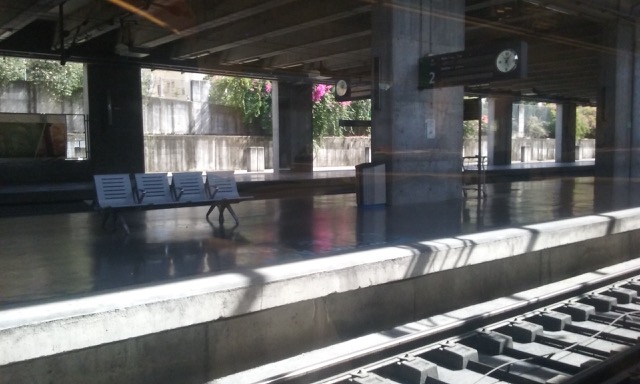
Unless one is in a desperate time crunch, why would anyone choose to fly within Spain? Take the check-in. One must be at the airport at least an hour before a flight, while you can roll in just minutes before your departure to catch a train. With trains, there are no worries of overweight, having too many pieces of luggage, as long as you can manage to drag your suitcases along. You can bring along a bottle or two of preferred choice of fluids, a basket of fresh fruit and an entire beauty bag of full-sized perfumes, cremes and lotions. Once onboard, one will rarely be asked to show ones tickets. In fact, on a recent journey to the capital, we did not see a single official representative on the train, other than the one bringing the bar trolley along at steady refill intervals. Train travel does not involve removing belts, jewellery, shoes and what have you. You will not be frisked nor be forced to go through the all-revealing, full-figure, hands-up, circular scanning chamber. In short, you can still enter a Spanish train with your self-respect and outfit intact!
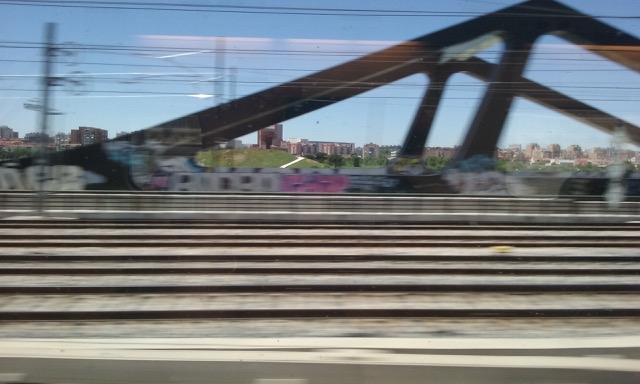
Time-wise, trains are admittedly slower than flying. However, with Spain’s AVE trains average running speed of 150 - 200 km/h (they can go up to about 350), we can get from Ronda to Madrid in four hours and to Barcelona in just over eight. Calculating the drive to the airport, the additional time required for check-in, the waiting at the tarmac, the slow loading and off-loading, the endless airport corridors, the wait for the suitcases and the bottleneck at the final security exit, there are actually few minutes to be saved by taking a national flight in Spain. Added to this is the fact that most major airports are located far outside the big cities to whom they pertain, while train stations are usually located smack in the centre of the city, usually making it a shorter cab-ride to ones final destination. There is clearly time and money to be saved on international air travel, but for in-nation trips trains are quite competitive. Those who have entered the Golden Age can apply for La Tarjeta Dorada, which for merely 6 euro per annum gives generous senior discounts. I am not there yet, but there is always something to look forward to when one does cross that milepost…

Comparing fuel costs to train tickets, it is cheaper to drive than take the train, certainly if you are a family or a group of friends. But this means that at least one of you have to be the designated driver, needing to worry about traffic police and watching out for head-on collisions. Then there are speed traps, carsickness, roadblocks, accidents and construction, taking the wrong turnoff and trying to get back on the Autovía without a 10 km detour, unexplainable bumper-to-bumper delays on the highway, the we-need-to-stop-at-the-next-washroom conundrum, running out of fuel, the driver falling asleep at the wheel, or untimely engine trouble. Finally, there is the question of how to ‘get rid off’ the car or where to park when you arrive at the destination. On a train, everyone gets to enjoy the view and can have a glass of wine with lunch. Indeed, it is the ultimate democratic mode of travel.
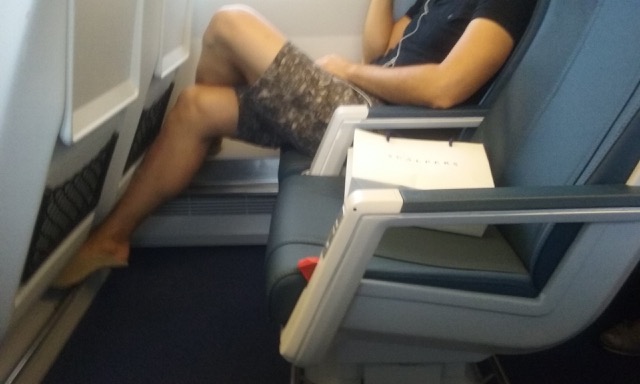
In my experience, the Spanish trains are generally comfortable, spacious and clean. On longer train rides, seats are assigned, while local trains have free seating. Luggage is stored at the end of the carriages, or in the open hat shelf above, which fits even the most overstuffed Japanese suitcase. Compared to airplanes, train seats are wider, cushier, and lastly something quite vital, there is ample legroom for even the lankiest teenager to kick of their alpargatas. There are no compulsory security announcements, blinking seat belts signs, air-masks above, nor flotation devices beneath one’s seat. The train windows offer wide panoramic views on both sides, as opposed to an airplane’s tiny portholes. One can walk freely about on trains, enter the washrooms at any time, or spend basically the entire ride in one of the train’s bar carriages, which have a better menu than most flights I have been on. If you do not wish to move, the food trolley will come to you. And even the coffee is decent! Like most airlines, you are offered headphones and free films on Spanish long-distance trains. There is no entertainment choice, and it is usually a dubbed, American B movie, a Spanish sitcom or a cartoon to keep the kids quiet (There are adult-only train cabins, though I am yet to verify if the films are ‘adult’, as well.) But with the stunning Spanish landscape passing by, a café con leche or a tinto and a good book in hand, who needs movies?
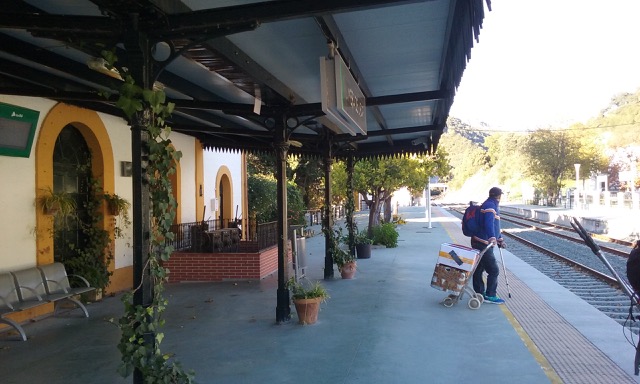
Local Spanish trains chug along at a more leisurely speed and may be a bit worn at the edges, but they generally run on time and get one to ones destination in safety and comfort. There are countless Andalucian villages, many that time seem to have forgotten, with charming stations, some even still receiving trains. Take the station in Jimera de Libar. Though the village only has 450 aging residents, it is a regular stop on the Algeciras train route. Here, the stationmaster will still come out in his classic conductor cap to wave a red flag and blow his whistle. Whether he or his kin are responsible for the upkeep of the station, they should receive the award of the year for the station with the most character. All along the platform and on the station house there are floor to ceiling creepers, hanging potted plants, old lanterns and a couple of shrines to some virgin or another. In spring, the orange groves and lemon trees nearby makes one feel that one has come to an olfactory heaven. There are benches to sit on and shade to be had for all.
Should you have an hour to spare before your train departs, across the rails a few hundred meters along is the local pub where the English/Danish hosts make their own brew and serve curry, bratwurst and even Mexican fare. It is such a welcoming place that you might be tempted to miss your train. So hurry up slowly, as there are only four trains per day and yours is likely to be the last one…
